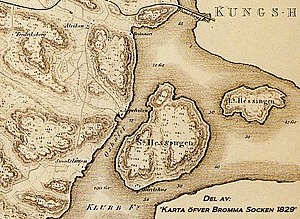Stora Essingen
| Stora Essingen | ||
|---|---|---|
| Stora and Lilla Essingen 1829 | ||
| Waters | Mälaren | |
| Geographical location | 59 ° 19 ′ 16 ″ N , 17 ° 59 ′ 20 ″ E | |
|
|
||
| surface | 73 ha | |
| Residents | 3892 (2006) 5332 inhabitants / km² |
|
Stora Essingen is a 73 hectare island in the Swedish lake Mälaren and at the same time a district of the Stockholm district of Kungsholmen with 3892 inhabitants (2006). The island is very hilly and used to be called Hessingen.
Adjacent Stockholm districts are Fredhäll, Lilla Essingen , Gröndal, Smedslätten, Äppelviken and Alvik. Stora Essingen was incorporated into the Stockholm metropolitan area in 1916 as part of Bromma . After several administrative reforms, the island is now part of the inner-city district of Kungsholmen. In addition to the Essinge Church by the architect Cyrillus Johansson , located on the highest point of the island and whose bell tower is a landmark that can be seen from afar, there is also a chapel of the Liberal Catholic Church (S: t Mikaels och Alla Änglars kyrka).
The first workers' apartments and summer houses were built in the 1870s. From 1907 onwards, individual properties were sold, but it was not until 1929, after the opening of the first Essingen bridge, that interest in them increased significantly. Today, the area around the central square is characterized by apartment buildings and the remaining areas of the island by villas.
On December 15, 1928, Stora Essingen was connected to the Stockholm bus network and trolleybuses operated on the route to the island between 1945 and 1961 . With the construction of the Essingeleden in the 1960s, a motorway with two distinctive bridges now touches the northeastern part of the island. The tram line ( Tvärbanan ) is more recent. It was completed in 2000.
Individual evidence
- ↑ Nils Carl Aspen Mountain: The road and suburban trains in Stockholm . Baneforlaget, Oslo 1994, ISBN 82-91448-08-6 , pp. 31-37 .


